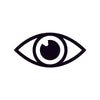10 signs you might need an eye test
A thorough eye exam every two years ensures your vision remains clear — with or without prescription lenses. If you’re 65 or over, a yearly eye test is recommended.
However, even if you aren’t due for an eye test, certain symptoms and indicators should prompt you to visit your eye doctor sooner rather than later. They are:
1. Hazy or blurry vision
When you have trouble seeing details in objects, reading or recognising faces, you may need vision correction with contact lenses or prescription glasses frames.
2. Visual disturbances (spots, floaters, flashes of light, halos, etc.)
If you suddenly start seeing spots, flashes of light, halos, floaters or other visual disturbances, get medical attention immediately by seeing an optometrist, ophthalmologist or your healthcare provider.
3. Squinting a lot
If you find yourself squinting to make images clearer, you’ll need an eye exam to determine whether wearing glasses can resolve the issue.
4. Frequent headaches
While headaches can be a symptom of various medical conditions, they may be eye-related, especially if you experience them after working on a computer or looking at a digital screen for an extended period.
5. Sensitivity to light
If you find your eyes suddenly becoming light-sensitive, get an eye exam. It can be a symptom of an eye disease or infection.
6. Eye pain, strain or fatigue
If you spend a lot of time working on a computer and other similar devices or engage in long-distance driving, you may experience eye fatigue, pain or strain. If your eyes have trouble focusing after, you may need glasses to correct the problem.
7. Eye infection
You may have an eye infection if you notice some swelling on the eyelids, discharge or redness in one or both eyes, or if you experience itching. If you observe any of these signs, get an eye check-up right away.
8. Watery eyes
Watery eyes may indicate visual issues, but they can also be a sign of other problems, such as allergies. If watery eyes bother you, get your eyes checked immediately.
9. Trouble seeing at night
You may be suffering from night blindness, or nyctalopia, if you have problems seeing at night or in low light. Patients who suffer from night blindness can also experience sensitivity to light. If you observe these signs, go for an eye test.
10. Distorted vision
If you start seeing straight objects like blinds or shades as wavy, bent, or misshapen, or you experience distorted or double vision, go to an eye doctor and get a diagnosis. These can all be signs of deteriorating eye health.
Outside of these factors, there are other factors to consider in deciding how often you should get your eyes tested in Australia, such as:
Age
Age is a key factor in your vision. While all people experience vision problems at some point in time, some people may be more vulnerable to developing issues with their eyesight than others. Certain age groups, for example, are more likely to develop vision problems and require prescription eyewear.
Young children
Since some childhood learning difficulties are associated with undiagnosed vision problems, it’s recommended for kids to have their first eye test at the age of 3. This way, early detection and correction are possible.
Also, since eye health is important to your child’s growth and development, regular eye tests are advised. Aside from helping identify and manage vision problems early on, the test will also help your child feel at ease with eye exams.
Teens
Kids typically develop myopia once they hit puberty. The onset of myopia or near-sightedness during this stage would require most teenagers to use prescription eyewear.
This is why teenagers must get comfortable getting regular eye exams. When teenagers have untreated vision problems, these can affect various aspects of their life, including their ability to participate in athletic activities, work, or study.
Over 40s
As people grow older, the human body's cells lose their ability to regenerate, including those in the eyes. The lenses lose their elasticity and ability to change shape inside the eye. This condition is known as presbyopia, resulting in a loss of the capacity to focus effectively on objects close to one’s line of sight.
People with this ailment must hold objects farther from their eyes to see the items clearly, which often becomes apparent among people in their mid-40s.
This is why it’s crucial to have regular eye exams once you reach this age. Most age-related disorders can be addressed effectively with an early diagnosis.


